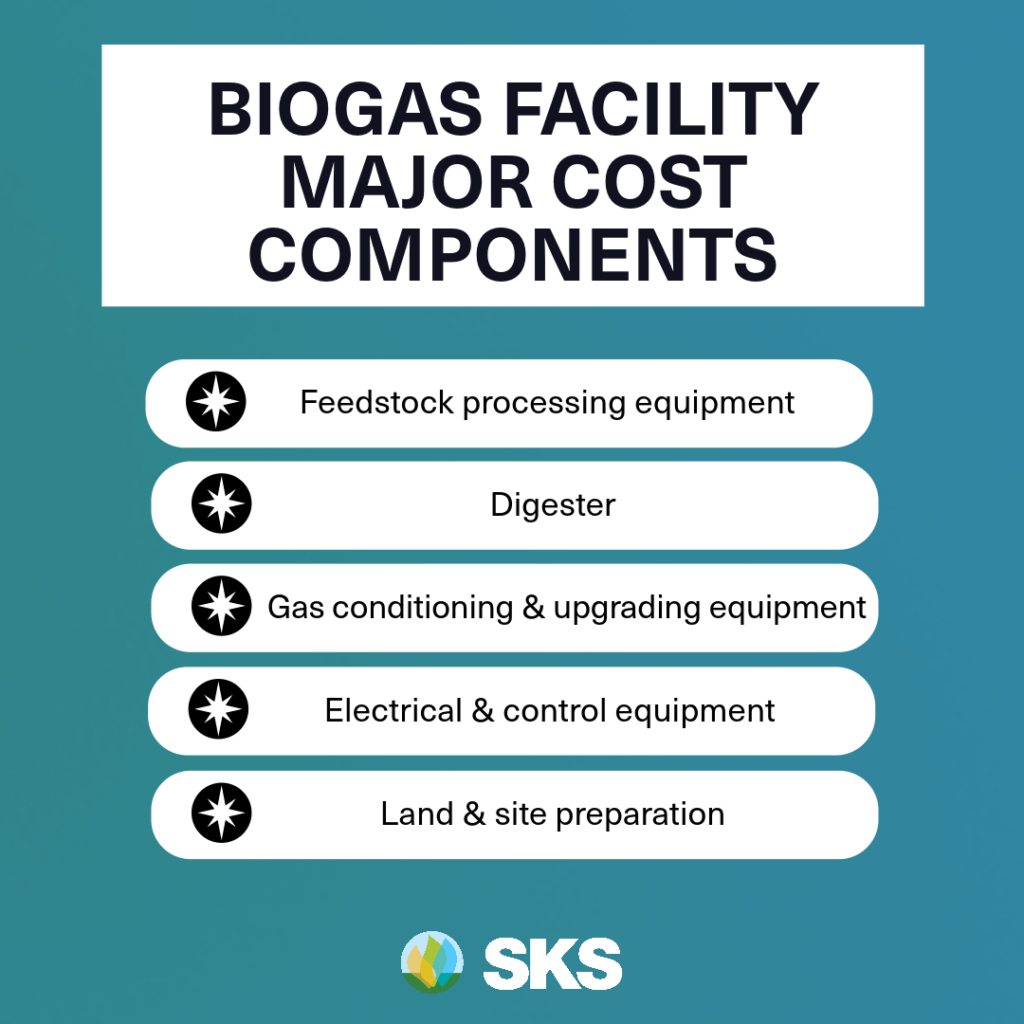Biogas facilities are becoming increasingly popular as a way to generate renewable energy and reduce waste. Biogas is a renewable energy source that can be produced from organic waste, such as food scraps or animal waste. It is a clean and efficient fuel that can be used to generate heat and electricity and power vehicles.
The cost of building a biogas facility can vary widely depending on a number of factors, including the size of the facility, the type of feedstock used, and the location of the facility. In general, the cost of building a biogas facility is estimated to be between $400 and $1,500 per wet ton of material processed, according to Biogas World.
Despite the sizable initial investment, biogas facilities can be very profitable. Purified biogas, or renewable natural gas (RNG), can generate revenue in many ways, including, for example, by selling the RNG to energy companies, which can then sell it to consumers and capture valuable environmental incentives. Other byproducts of the biogas production process have the potential to be monetized as well, such as digestate, which can be sold for use as a nutrient-rich fertilizer, livestock bedding, or a soil amendment.
In this article, we will discuss the major cost components of a biogas facility, as well as some ways to reduce the cost and make your biogas facility more profitable.
Major Cost Components
The typical cost of building a biogas facility can vary widely depending on the size and complexity of the facility, as well as the location. Before building a biogas facility, it is important to carefully consider all of the costs involved.
The major cost components of a biogas facility include:
- Feedstock processing equipment: The equipment needed to collect, separate, and pretreat feedstock so that it is suitable for anaerobic digestion can vary depending on the type and volume of feedstock as well as the existing management and handling practices.
- Digester: The digester is the heart of the biogas facility, and it accounts for a significant portion of the total cost. The cost of the digester depends on its size, which is driven by the volume of material it needs to process, and the type of material it is made from. Mixing, heating, and safety systems add to the cost of the digester.
- Gas conditioning and upgrading equipment: This equipment is used to remove impurities from the biogas and compress it to the required pressure so that it can meet utility specifications for injection into the natural gas pipeline. It includes filtration systems, gas compressors, storage tanks, and pipelines.
- Electrical and control equipment: This equipment is integrated throughout the biogas facility so that all systems and processes can be operated and the flow of feedstock, biogas, and RNG can be controlled and documented.
- Land and site preparation: The cost of land and site preparation can be significant, especially if the facility is located in a remote area. Local geologic and environmental conditions can also increase site costs.
In addition to the initial capital costs, there are also ongoing operational costs associated with a biogas facility. These costs include the cost of feedstock, labor, utilities, spare parts, maintenance, and repairs.

Tips for Maximizing Operational Profitability
The cost of a biogas facility can be a significant barrier to entry for some project owners and investors. However, there are a number of ways to maximize the profitability of a biogas facility.
1. Choose a location that minimizes transportation costs
The financial viability of a biogas plant is often dependent on its proximity to reliable and consistent feedstock sources and natural gas injection sites. Therefore, it is important to choose a location that minimizes transportation costs for both the feedstock and the energy.
Proximity to feedstock: The cost of trucking feedstock can be burdensome to a project’s economics, especially for feedstocks with a high liquid content, such as manure and food waste. Choosing a project location that is adjacent to or nearby where the feedstock is generated can help reduce transportation costs.
Proximity to the natural gas pipeline: RNG typically must be transported to a natural gas pipeline for injection into the grid. Often, the most cost-effective strategy involves transporting it from the biogas facility to the injection point via a dedicated pipeline. In instances where the distance to the injection site makes the cost of constructing a pipeline infeasible, trucking the gas via a “virtual pipeline” may become necessary. Either of these options – constructing a pipeline or trucking the gas – can be prohibitively expensive, especially for large-scale projects involving sizable volumes of RNG that must be transported over long distances.
2. Use high-quality materials and construction methods
Biogas facilities are long-term assets and the quality of the materials and construction methods used to build your biogas facility will have a significant impact on its operating costs and lifespan. It is important to use high-quality materials and to hire experienced contractors to build your facility so that you minimize the cost of repairs, maintenance, and replacement parts during operations.
3. Implement efficient operating procedures
The operating procedures you implement at your biogas facility can have a significant impact on its profitability. It is important to develop and implement efficient operating procedures that minimize costs and maximize biogas production. Our partners at Taurus Biogas provide comprehensive management services to maximize the value of your biogas facility
4. Optimize gas production
Maximizing gas production is a crucial pillar in ensuring the operational profitability of a biogas facility. By striving for optimal system uptime and ensuring that biogas meets the stringent specifications required for injection into the natural gas pipeline, operators can maximize their revenue potential and minimize losses.
Every minute of downtime translates into lost production and missed opportunities for monetization. Therefore, implementing proactive maintenance strategies and minimizing unplanned outages are essential for ensuring optimal system uptime.
In addition to ensuring system reliability, operators must also focus on producing biogas that meets the specifications for pipeline injection. By carefully monitoring and controlling key process parameters, biogas facilities can produce RNG that meets pipeline operator requirements and avoid flaring.
5. Determine the best gas monetization strategy
There are a number of different markets available for RNG, including regulated and voluntary markets. Regulated markets are those in which regulated parties (typically petroleum importers, refiners, and wholesalers) are required to produce or purchase a certain percentage of low carbon fuels such as RNG or satisfy such requirements by purchasing the equivalent quantity of environmental incentives. Voluntary markets are those in which buyers (typically utilities, universities, and corporations) purchase RNG on a voluntary basis to reduce their carbon footprint, typically at a market-based price.
There is also a myriad of ways to structure offtake agreements for RNG. Offtake agreements are contracts between the RNG producer and the buyer that specify the terms of the sale, such as price, volume, and duration. Offtake agreements can be short-term or long-term and can be priced at a market rate or a fixed rate.
It is critical for the project owners to determine their preferred gas monetization strategy based on their risk/reward preferences and to maintain flexibility to shift their strategy as market dynamics change.
6. Maximize government subsidies and incentives
There are many federal and state subsidies and environmental incentives available for biogas production that can help to reduce the cost of building and operating a biogas facility. Working with experienced experts will help ensure you don’t leave anything on the table that can help offset the cost of your biogas facility.
Resources for Evaluating the Financial Feasibility of a Biogas Facility
The financial feasibility of a biogas facility depends on a number of factors, including the cost of feedstock, construction costs, marketplace conditions for RNG and environmental incentives, operational costs, and the availability of government incentives.
A few feasibility analysis tools recommended by the United States Environmental Protection Agency include:
- Cost of Renewable Energy Spreadsheet Tool (CREST)
- An Economic Evaluation Tool for Farm-Based Anaerobic Digesters
- AD Budget Calculator
- Anaerobic Digestion Financial Decision Tools
While building a biogas facility can be a significant investment, it can also be a very profitable one. With the right design and operation, a biogas facility can generate a steady stream of revenue.
SKS is a leading provider of customized biogas facilities. With our deep understanding of the biogas industry, we are committed to helping our clients design and operate profitable facilities. We can assist with every aspect of your biogas project, from site selection and design to construction and operation. We will collaborate with you to create a customized biogas facility that meets your specific needs and budget.
If you are interested in learning more about how SKS can help you design and operate a profitable biogas facility, reach out to the SKS team. We would be happy to answer any questions you have.
